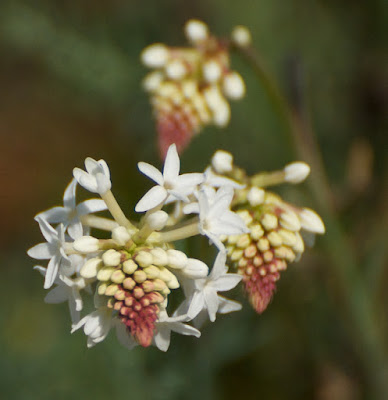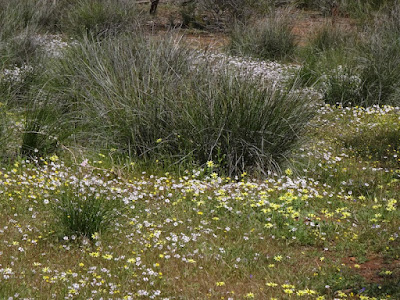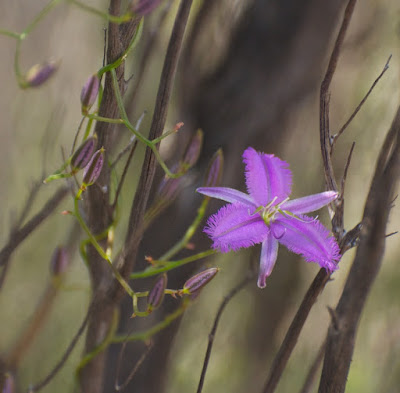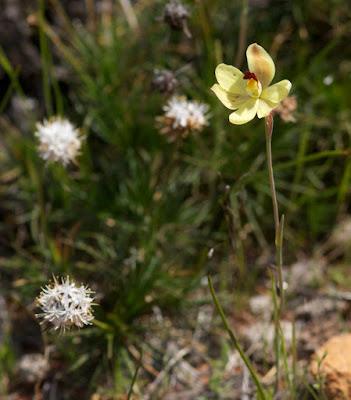Colonists and camels aside, the Camel Soak is an attractive granite outcrop, surrounded by brush and topped by a few pools among the rocks. These are some of the most ancient rocks in the world, dating back to the long-ago Archaean Period when what life their was consisted, mostly, of single-called organisms bobbing in stagnant pools (perhaps, indeed, much like this one).
The pools bring in a few things you might not associate with the desert, including numbers of large tadpoles.
I have been trying to determine what sort of frog these tadpoles, if they are lucky, will develop into, but so far without success (though I am certainly not the only person to have noticed them).
This dragonfly was not so fortunate. As with the tadpoles, I have been trying to find out exactly what it is. I am still waiting for some expert advice, but in the meantime I will hazard a guess that this is a Blue Skimmer (Orthetrum caledonicum), one of Australia's relatively few libellulids (the dominant dragonfly family elsewhere).
The mound of granite forming the outcrop itself was, not surprisingly, almost bare of plant life, though tucked away among the rocks I did find this peculiar mound of greyish vegetation. It turns out that granite outcrops in Western Australia, particularly in transition zones between the coast and the inland deserts, are habitat for some sixteen species of so-called 'cushion plants' - dense, closely-growing plant mounds that may accumulate peat among their intertwined roots - from a number of different plant families. I admit this surprised me - I had heard about cushion plants, but thought that this particular plant lifestyle was confined to windswept arctic or subantarctic landscapes, or Alpine Zones like the mountains of New Zealand where I had seen them a few years earlier.
The surrounding bush at the base of the outcrop, though, was heavy with more normal-looking vegetation, and rich with windflowers.
Creamy Candles (Stackhousia monogyna) was s plant that, by now, we had seen many times before....
....but never, I think, in such abundance.
Many of its inflorescences were not yet fully open, but the bright red buds lent their plants a touch of colour that plants with fully opened flowers could not match.
There were, indeed, flowers everywhere around the base of the outcrop.
Poverty bushes (Eremophila) - over 200 species of them - are typical of the dry Australian interior. This one is probably Drummond's Poverty Bush (Eremophila drummondii). Birders will recognize the scientific name: Eremophila is also the name of the Horned Larks of the Northern Hemisphere. Though the rules of nomenclature do not allow generic names to be used more than once for animals, or for plants, it is perfectly OK for an animal to have the same generic name as a plant. Indeed, many do. 'Eremophila' means, roughly, "lover of lonely places", so in this case it works equally well for both plant and bird. As for the name "poverty bush", I presume it refers to the barren country these plants prefer. They are also called 'emu bushes', and indeed Emus (Dromaius novaehollandiae) eat their fruits and disperse their seeds.
We were probably a bit early in the season for the height of the Camel Soak flower show. Orange Immortelles (Waitzia acuminata) were not yet fully open (though they are lovely enough in bud).
Pink Everlastings (Schoenia cassiniana) were already in full bloom, but I have seen photos of them carpeting the ground here - so either we were early, or the rains had not been as heavy in 2013 as they are in other years (in fact we were told that, as flower-rich as the countryside was, we had not come in one of Western Australia's best years. It was certainly good enough for me, mind you.
Flannel Cudweed (Actinobole uliginosum), like the immortelles and everlastings, is a composite (Family Asteraceae). The word 'flannel' is part of the name of a number of unrelated plants that grow in the Australian interior, and refers to their common feature - a more or less dense coat of white, woolly hairs. Flannel outerwear both reflects away the intense light of the sun and provides a shady boundary layer that protects the surface of the plant from burning and water loss.
Flannel Bush (Solanum lasiophyllum) belongs to the same genus as potatoes and tomatoes (their flowers certainly look alike)...
...but shares a taste for woolly coats with the cudweed (and, presumably, for the same reason).
Tall Mulla Mulla (Ptilotus nobilis) is one of a number of similar plants of the Australian interior, also known (for obvious reasons) as pussy tails. It is a member of the amaranth family (Amaranthaceae).
This is one of the fringe lilies (Thysanotus sp.), named for the delicate fringe of purple hairs edging the petals. Fringe lilies, despite their name, are actually members of the asparagus family (Asparagaceae).
Velvet Pink (Petrorhagia dubia) is a relative of the garden pinks (Caryophyllaceae) - named, by the way, not for their colour but for the toothed edges of their petals, which look as though they have been trimmed with a pair of pinking shears.
Phebalium is an endemic Australian member of the rue or citrus family (Rutaceae). This one is possibly P. tuberculosum.
Among the Phebaliums were the aristocrats of the Western Australan flora: orchids, and the Camel Soak proved to be a very good place for them.
Not everyone in our little group was as interested in botanical minutiae as I was, but orchids were a different matter. That's Rita, our chief organizer, on the left.
Of course, I tended to be the one who would go to the greatest lengths to get up close and personal with any orchids we saw.
Here, viewed from a variety of angles, is a Lemon-scented Sun Orchid or Vanilla Orchid (Thelymitra antennifera).
Here are some more, this time two to a stalk.
Much less noticeable, but delightfully named, is the Little Laughing Leek Orchid (Prasophyllum gracile).
There are many species of very similar-looking donkey orchids in Western Australia, but I think that this one may be the very local Mini Donkey Orchid (Diuris recurva).
After all the flowers, I think I should end this post with an animal or two. The Australian Painted Lady (Vanessa kershawi) is the Australian replacement for the otherwise almost globally-distributed Painted Lady (V. cardui) of other lands. It is found pretty much throughout the continent.
One sure sign that we are in dry country - and a particularly attractive one - is the presence of the Red-capped Robin (Petroica goodenovii) - a favourite bird of mine, for what I hope are obvious reasons!




















































No comments:
Post a Comment